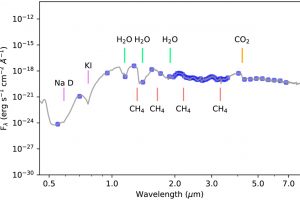A binary system in orbital synchronization. The study: “The GAPS programme at TNG. XLIII. A massive brown dwarf orbiting the active M dwarf TOI-5375” of J. Maldonado (INAF – OAPA) appeared on A&A

Nature sets a lower limit on stellar masses: objects less massive than 0.07-0.08 solar masses are incapable of initiating the thermonuclear reactions that power more massive stars. Below this threshold lies the realm of brown dwarfs, objects whose mass is too small to qualify as stars, yet too large to be categorized as planets.
The mechanism responsible for the formation of the brown dwarfs is still under analysis. Such small objects can form as normal stars—via the gravitational collapse of gas and dust clouds—or similar to the formation of planets. In the latter scenario, brown dwarfs might form within protoplanetary disks orbiting around young stars, accumulating gas onto massive rocky cores, or arising from the gravitational fragmentation of these disks. The investigation of brown dwarfs within binary systems could provide astronomers with insights into the primary formation mechanism of brown dwarfs.
TOI-5375 is an M0.5 star, characterized by an effective temperature of approximately 3700 K, located at a distance of around 400 light years from the Sun. It is recognized for hosting a low mass companion, prompting observations of this star within the context of the GAPS (Global Architecture of Planetary Systems) project. The team headed by the astronomer J. Maldonado (INAF – Astronomical Observatory of Palermo) has examined an extensive series of photometric observations gathered using the NASA satellite TESS, as well as spectroscopic observations acquired using the HARPS-N spectrograph mounted on the Telescopio Nazionale Galileo. This analysis has confirmed the companion’s low mass (designated as TOI-5375 b), which corresponds to 77 Jupiter masses. Furthermore, astronomers have determined that the orbital period of TOI-5375 b has experienced a delay of approximately 20 seconds over the course of 10 years. This suggests that the star is synchronizing its rotation period with the orbital period of the low-mass companion due to tidal effects. The findings of this study are described in the paper titled: “The GAPS programme at TNG. XLIII. A massive brown dwarf orbiting the active M dwarf TOI-5375“, recently published in the journal Astronomy & Astrophysics.
The researchers have also simulated future observations of TOI-5375 b with the ESA satellite ARIEL, scheduled for launch in 2029. The simulated spectrum (accessible through this link) displays characteristics of molecules that are expected to exist in the atmosphere of this low-mass object, including water, carbon dioxide, and methane.
Mario Giuseppe Guarcello ( follow mariospiegacose) ( mariospiegacose) ( follow mariospiegacose)
Follow the Astronomical Observatory of Palermo on Facebok and on Instagram
Subscribe the Youtube channel of the Astronomical Observatory of Palermo
